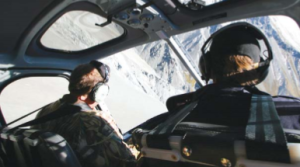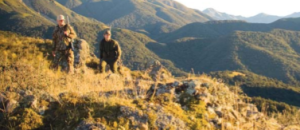THE PERFECT KIWI HUNT
FREE RANGE OR GAME ESTATE? FOOT OR FLY? PUBLIC OR PRIVATE LAND? A GUIDE TO SELECTING THE BEST NEW ZEALAND ADVENTURE FOR YOU | SECOND OF FOUR PARTS
By Simon Guild
Editor’s note: This is part two of a four-part series on New Zealand hunting. Last issue reviewed the country’s modern hunting history.
OK, so you have a dream of hunting red stag in New Zealand. You jump online and start researching outfitters.
You quickly work out there are more than 100 such companies to choose from, all offering variations on the big New Zealand trophy species, along with the appropriate superlative claims of being the best there is. There is also a wide range of prices, and not being one to pay more than you need to, you select outfitters based on what they promise, with one eye firmly fixed on the dollars involved.
There is one operation that lures you in. The claims are impressive – a 100-percent success rate, record-quality free-range animals, guarantees and, best of all, the price seems too good to be true.

You book your trip and before you know it, you’ve landed in New Zealand, and are en route to the hunting area. Yes, the guide was late on the pickup and the accommodations are less than expected. But hey, you’re here for the hunting and the hunting looks impressive. You hunt hard for the next five days and see a few smaller stags, but nothing like what you’ve been promised. That’s what it’s all about, you tell yourself; the trophy has to be earned and you’ve put in the hard yards before. But nothing shows up over the next two days.
You start to wonder, and then your guide approaches you. He’s aware that you need to fly home in three days; and if you want to take a trophy home, he has another place you can try. It’ll cost a little more, he says, but it’s guaranteed. Reluctantly, you agree to the extra money and pack up camp.
The new place looks OK, and within the first few hours you see a multitude of stags of the quality you seek. You bite the bullet and spend that money burning a hole in your pocket; but who cares, you have the stag of a lifetime! You get home and submit your monster free-range trophy to the record book. Well done, they say; just sign the declaration and get your outfitter to do the same.
However, the outfitter refuses. The stag isn’t free-range, but a selectively bred animal released illegally. You soon realize that anyone with an informed eye can tell this in an instant. Your dream hunt has turned into a nightmare.
This type of story is rare, but it has happened.
Hunting in New Zealand is largely unregulated and virtually anyone can pick up a rifle and call a guide, which opens the door for substandard operators to prey on the unwary. The purpose of this portion of our four-part series is to educate you, the hunter. There are different hunting options and environments in New Zealand, and we hope that you can choose the right one with confidence.
FREE RANGE OR GAME ESTATE?
There are two primary types of recognized legitimate hunting environments in New Zealand. One is free-range, where animals should be wild in every sense of the word; the other is game estate, where animals are managed within an enclosure for the express purpose of hunting.
Free-range is pretty self-explanatory. By definition, free-range animals should be born and raised as part of a wild population, with no barriers to roam, be they natural or manmade, end of story.
All New Zealand game species exist in free-range environments, either in pockets or widespread throughout the country. A genuine New Zealand free-range hunt is one to truly be proud of, regardless of the species or trophy taken. Herein lies the key: If it’s a massive trophy you want, then free-range is possibly not the option for you.
Invariably, a free-range trophy will be more challenging to hunt than the game-estate equivalent. It will also be smaller on average. The dimorphism between free-range and estate is pronounced in some species, no more so than red stag hunts. Indeed, a 300-inch free-range stag is an alltime trophy, compared to estate animals that are currently topping an extraordinary 700 inches.
Free-range environments exist on both public and private land. The former is a free-for-all, where the most dedicated local and overseas hunter wins, while private land can yield some incredibly good trophies for the hunter prepared to pay a bit more for the privilege. But regardless, every genuine free-range trophy should be from a genuine wild hunt.
Game estates, also known as safari parks, game parks or hunting

estates, are a more complex beast. Hunters should be aware that it is not illegal to shoot an animal on a farm in New Zealand. With this scenario as an absolute baseline, hunters need to exercise considerable discretion when it comes to selecting the right property, as acreages and animal “wildness” can vary hugely.
To this end, the New Zealand Association of Game Estates (NZAGE) sets rigid standards around hunting properties, of which there are 20 or so members. These standards are primarily concerned with the client’s safety, the animal’s welfare and the sanctity of a fair-chase hunt. The term “fair chase” is vital here; basically, the animal needs to have both the opportunity and the inclination to evade the hunter.
Game estates will invariably deliver the hunter a wider range of considerably better quality trophies of any given species than a free-range environment. However, the onus is on the hunter to do the research to ensure that the hunting experience can live up to the quality of the trophies on offer.
There is a third “option,” one that many in our industry, including me, are quick to dismiss on the grounds that it is both illegal and a lie. This is the “released free-range” trophy, as described in the aforementioned nightmare scenario. In a nutshell, a farm-raised animal is released into a free-range environment and passed off as a free-range trophy. This happens most frequently in the case of red stag. If this is something that doesn’t sit well with you, ask some hard questions of any outfitter who promises a free-range red stag trophy over 320 Safari Club International points.
FOOT OR FLY?
In New Zealand, we have less restriction on the use of helicopters in hunting than many of the countries from which our clients come from. Primarily utilized in the free-range environment, the ability for hunters to use helicopters to assist in the hunt is extensive, ranging from access only, where the hunter and guide alight to complete the location and stalking of animals on foot, through to aerially assisted trophy hunting, or AATH.
AATH involves extensive use of the aircraft to access the hunting area, locate the target species, set the hunter down in proximity to the animal and then facilitate trophy recovery.
Whether you choose to hunt on foot alone, utilize a helicopter for access or go the full AATH depends on a number of factors: time, budget, fitness and your own internal hunter’s code.
Invariably, when you involve a helicopter, the cost will go up, the time required will go down and the fitness required will become less of an issue. For example, a successful wilderness hunt for a bull tahr involving foot access and spike camps could take five days or longer. By contrast, a successful AATH could be achieved in a morning.
As far as which outfitters to use – again, this is entirely down to the hunter to research – some outfitters are 100-percent foot hunters and some may employ helicopters for access; others specialize in AATH. Of course, many will offer the whole gamut. The trick here is not to be goaded into a more convenient, profitable or easier method than you originally intended because that is what suits the outfitter.
PUBLIC LAND VERSUS PRIVATE LAND Like most hunting locations, New Zealand is no different in that we have the option of hunting both public and privately owned land. Again, the option you choose will come down to the same criteria as the helicopter versus foot decision: time, money, fitness and ethics.
Public land, by its intended nature, is a free-for-all. There is no such thing as an exclusive concession on any public land in New Zealand, despite claims to the contrary. Not only could a hunter be competing with other guides and their clients, but also the New Zealand hunting public. In short, you don’t know whom you’ll be sharing your hunting area with.
Access is a big consideration, and the easier the country, the greater the hunting pressure. That will make it harder to find a good trophy. Chances can be greatly increased by heading further back into the wilderness – either under one’s own steam or by aid of helicopter. That adds cost but saves time and energy in the process.
On the other hand, private land allows the hunter access to land that can and should be managed (in this sense) for the purposes of trophy hunting. Of course, the flip side is greater cost in terms of access fees, trophy fees or both. Private land can be either free-range or game estate (i.e. fenced), as described earlier. When hunting private

land, hunters should expect better access, game management, safety, trophy quality, trophy abundance and lodging as benefits.
Of course, many New Zealand hunting adventures involve a combination of free-range, game estate, public and private lands and could well utilize a helicopter somewhere in the mix. The key is selecting the right environment that best matches your trophy aspirations, budget, physical limitations and your de?nition of “a good hunt” for each trophy or experience you seek.
Hopefully you now have a better understanding of the hunting environments in New Zealand. In the next issue, we are going to explore a few fatal – in the sense of destroying a quality hunting experience – mistakes that hunters often make when booking their New Zealand adventure. CS
Editor’s note: Simon Guild is a director of High Peak, one of the oldest hunting estates in New Zealand. He and his brother Hamish co-wrote The Hunters’ Guidebook to New Zealand with the aim of providing quality decision-making guidelines to visiting international hunters. Find out more at huntingredstag.com.



